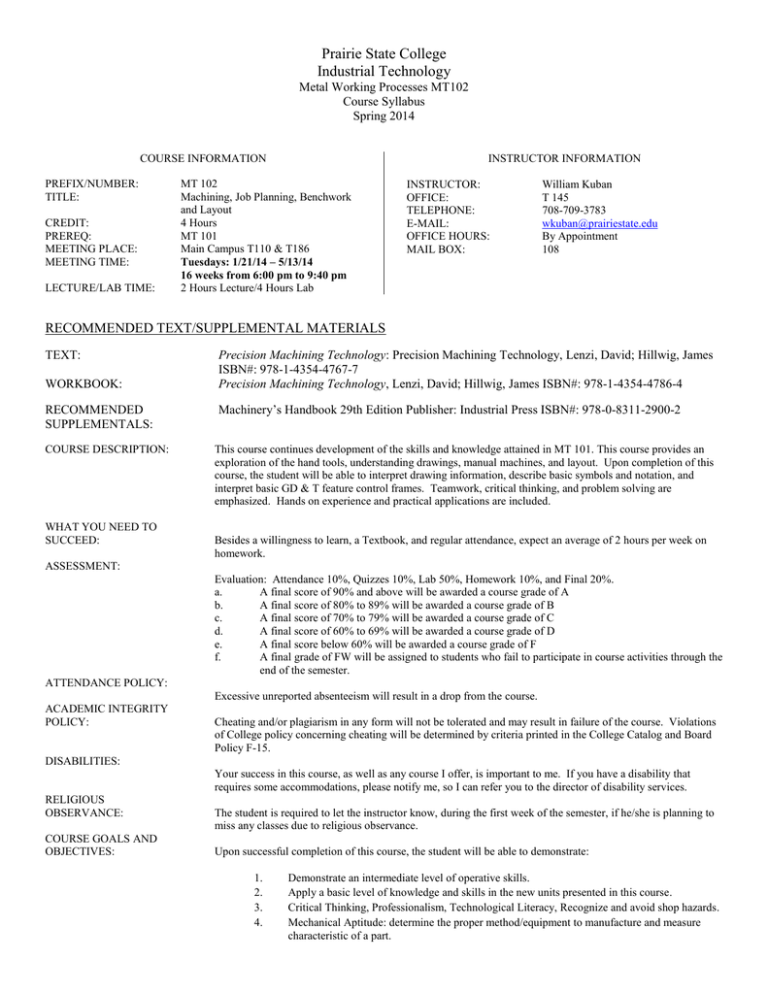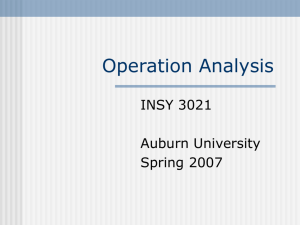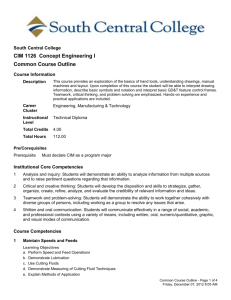Prairie State College Industrial Technology Metal Working
advertisement

Prairie State College Industrial Technology Metal Working Processes MT102 Course Syllabus Spring 2014 COURSE INFORMATION PREFIX/NUMBER: TITLE: CREDIT: PREREQ: MEETING PLACE: MEETING TIME: LECTURE/LAB TIME: INSTRUCTOR INFORMATION MT 102 Machining, Job Planning, Benchwork and Layout 4 Hours MT 101 Main Campus T110 & T186 Tuesdays: 1/21/14 – 5/13/14 16 weeks from 6:00 pm to 9:40 pm 2 Hours Lecture/4 Hours Lab INSTRUCTOR: OFFICE: TELEPHONE: E-MAIL: OFFICE HOURS: MAIL BOX: William Kuban T 145 708-709-3783 wkuban@prairiestate.edu By Appointment 108 RECOMMENDED TEXT/SUPPLEMENTAL MATERIALS TEXT: WORKBOOK: RECOMMENDED SUPPLEMENTALS: COURSE DESCRIPTION: WHAT YOU NEED TO SUCCEED: Precision Machining Technology: Precision Machining Technology, Lenzi, David; Hillwig, James ISBN#: 978-1-4354-4767-7 Precision Machining Technology, Lenzi, David; Hillwig, James ISBN#: 978-1-4354-4786-4 Machinery’s Handbook 29th Edition Publisher: Industrial Press ISBN#: 978-0-8311-2900-2 This course continues development of the skills and knowledge attained in MT 101. This course provides an exploration of the hand tools, understanding drawings, manual machines, and layout. Upon completion of this course, the student will be able to interpret drawing information, describe basic symbols and notation, and interpret basic GD & T feature control frames. Teamwork, critical thinking, and problem solving are emphasized. Hands on experience and practical applications are included. Besides a willingness to learn, a Textbook, and regular attendance, expect an average of 2 hours per week on homework. ASSESSMENT: Evaluation: Attendance 10%, Quizzes 10%, Lab 50%, Homework 10%, and Final 20%. a. A final score of 90% and above will be awarded a course grade of A b. A final score of 80% to 89% will be awarded a course grade of B c. A final score of 70% to 79% will be awarded a course grade of C d. A final score of 60% to 69% will be awarded a course grade of D e. A final score below 60% will be awarded a course grade of F f. A final grade of FW will be assigned to students who fail to participate in course activities through the end of the semester. ATTENDANCE POLICY: Excessive unreported absenteeism will result in a drop from the course. ACADEMIC INTEGRITY POLICY: Cheating and/or plagiarism in any form will not be tolerated and may result in failure of the course. Violations of College policy concerning cheating will be determined by criteria printed in the College Catalog and Board Policy F-15. DISABILITIES: Your success in this course, as well as any course I offer, is important to me. If you have a disability that requires some accommodations, please notify me, so I can refer you to the director of disability services. RELIGIOUS OBSERVANCE: COURSE GOALS AND OBJECTIVES: The student is required to let the instructor know, during the first week of the semester, if he/she is planning to miss any classes due to religious observance. Upon successful completion of this course, the student will be able to demonstrate: 1. 2. 3. 4. Demonstrate an intermediate level of operative skills. Apply a basic level of knowledge and skills in the new units presented in this course. Critical Thinking, Professionalism, Technological Literacy, Recognize and avoid shop hazards. Mechanical Aptitude: determine the proper method/equipment to manufacture and measure characteristic of a part. Course Layout Detailed topical course outline I. Access Drawings A. Explain Key Terms B. Utilize the Components of Engineering Drawings C. Create Title Block D. Describe Line Types II. Identify Basic Symbols and Notation A. Explain Fillet B. Interpret Rounds and Counter-bore C. Create Title Block D. Use Symbols and Notation III. Determine Tolerances A. Explain Bilateral Tolerances B. Explain Unilateral Tolerances C. Acknowledge Limit Tolerances D. Apply Maximum Material Condition (MMC) E. Apply Tolerance Specifications IV. Explain Types of Machines A. Adapt Safety Practices with Machines B. Demonstrate Basic Machine Maintenance C. Identify Tool and Blade Materials D. Develop an Understanding of Tool and Blade Characteristics V. Apply Classes of Fit A. Define Classes of Fit B. Demonstrate Allowances between Parts C. Describe Classifications of Fits VI. Define Geometric Dimensioning and Tolerancing (GD&T) A. Explain GD&T B. Use Drawing to Define Datum C. Demonstrate the Use of a Feature Control Frame D. Identify Flatness, Circularity and Cylindricity E. Define Profile and Location Tolerances F. Apply Run-Out Tolerances G. Describe Modifiers VII. Apply Layout Fundamentals A. Explain Key Layout Terms B. Use Layout Fluid C. Demonstrate Dye Remover Technique VIII. Demonstrate Semi-Precision Layout A. Explain Semi-Precision Layout B. Use Scriber C. Demonstrate Layout with a Combination Set D. Demonstrate Angle Layout with a Combination Set E. Use Center Punches and Other Hand Tools IX. Demonstrate Precision Layout A. Use Height Gage B. Demonstrate the Use of the Precision Angular C. Demonstrate the Use of the Vernier Bevel Protractor D. Use Sine Tools X. Apply Proper Hand Tool Use A. Identify Shop Tools B. Demonstrate Proper Tool Use C. Demonstrate Safe Shop Practices XI. Demonstrate Clamping Methods A. Explain the Different Clamping Methods B. Use C-Clamp C. Use Parallel Clamp D. Use Hinged Clamp XII. Exhibit Deburring Skills A. Explain File Classifications B. Define the Basic Parts of a File C. Select Proper File for Job D. Demonstrate File Cleaning XIII. Use Abrasives A. Explain Abrasives B. Choose Abrasive Material C. Demonstrate Deburring XIV. Apply Knowledge to Saws and Cutoff Machines A. Adapt Quality Terms B. Compare Inspection and Preventative Processes C. Calculate Speed and Feed D. Develop Sampling Plan E. Create Inspection Plan F. Define Statistical Process Control (SPC) XV. Develop Workholding Skills A. Explain Ferrous Metals B. Explain Nonferrous Metals C. Define Tempering D. Describe heat Treatment Process E. Characterize Hardness Scales and Testing XVI. Use Drill Press A. Demonstrate Drilling Operations B. Apply Countersinking, Spot-Facing, and Counterboring Practices C. Identify Various Tap Types and Tap Drill Selection D. Demonstrate Tap Removal Techniques XVII. Maintain Speeds and Feeds A. Perform Speed and Feed Operations B. Demonstrate Lubrication C. Use Cutting Fluids D. Demonstrate Measuring of Cutting Fluid Techniques E. Explain Methods of Application Methods of evaluation 1. Quizzes 2. Midterm and final examinations 3. Lab Projects All Chapter Questions are due on date provided. If you are absent that day you can turn in the work the following class you return. If you are present for class and do not turn in your homework it must be turned in the following class or you get a zero for the homework in question. NO EXCEPTIONS!! This workforce solution was funded by a grant awarded by the U.S. Department of Labor’s Employment and Training Administration. The solution was created by the grantee and does not necessarily reflect the official position of the U.S. Department of Labor. The Department of Labor makes no guarantees, warranties, or assurances of any kind, express or implied, with respect to such information, including any information on linked sites and including, but not limited to, accuracy of the information or its completeness, timelines, usefulness, adequacy, continued availability, or ownership. This solution is copyrighted by the institution that created it. Internal use, by an organization and/or personal use by an individual for non-commercial purposes, is permissible. All other uses require the prior authorization of the copyright holder.






